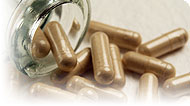Vitamin A

How to Use It
For most people, up to 25,000 IU (7,500 mcg) of vitamin A per day is considered safe. However, people over age 65 and those with liver disease should probably not supplement with more than 15,000 IU per day, unless supervised by a doctor. In women who could become pregnant, the maximum safe intake is being re-evaluated. However, less than 10,000 IU (3,000 mcg) per day is generally accepted as safe. There is concern that larger intakes could cause birth defects. Whether the average person would benefit from vitamin A supplementation remains unclear.
Where to Find It
Liver, dairy products, and cod liver oil are good sources of vitamin A. Vitamin A is also available in supplement form.
Possible Deficiencies
People who limit their consumption of liver, dairy foods, and beta-carotene-containing vegetables can develop a vitamin A deficiency. Extremely low birth weight babies (2.2 pounds or less) are at high risk of being born with a deficiency, and vitamin A shots given to these infants have been reported in double-blind research to reduce the risk of lung disease.1 The earliest deficiency sign is poor night vision. Deficiency symptoms can also include dry skin, increased risk of infections, and metaplasia (a precancerous condition). Severe deficiencies causing blindness are extremely rare in Western societies.
Less severe deficiencies are more likely to occur with a variety of conditions causing malabsorption. A high incidence of vitamin A deficiency in people infected with HIV has also been reported. People with hypothyroidism have an impaired ability to convert beta-carotene to vitamin A.2, 3 For this reason, some doctors suggest taking supplemental vitamin A (perhaps 5,000–10,000 IU per day) if they are not consuming adequate amounts in their diet.
Very old people with type 2 diabetes have shown a significant age-related decline in blood levels of vitamin A, irrespective of their dietary intake.4
Best Form to Take
Vitamin A is available in water-miscible, emulsified, solid, or oil-based preparations. Vitamin A toxicity is more likely to occur at much lower doses when it is delivered in water-miscible, emulsified, or solid preparations than when it is delivered in an oil-based form. This is believed to be because oil-based vitamin A has poorer bioavailability. However, beta-carotene, which can be converted in limited amounts to vitamin A in the body and does not lead to vitamin A toxicity in large doses, can be used in most cases to treat vitamin A deficiency.5
Copyright © 2024 TraceGains, Inc. All rights reserved.
Learn more about TraceGains, the company.
The information presented by TraceGains is for informational purposes only. It is based on scientific studies (human, animal, or in vitro), clinical experience, or traditional usage as cited in each article. The results reported may not necessarily occur in all individuals. Self-treatment is not recommended for life-threatening conditions that require medical treatment under a doctor's care. For many of the conditions discussed, treatment with prescription or over the counter medication is also available. Consult your doctor, practitioner, and/or pharmacist for any health problem and before using any supplements or before making any changes in prescribed medications. Information expires December 2024.















